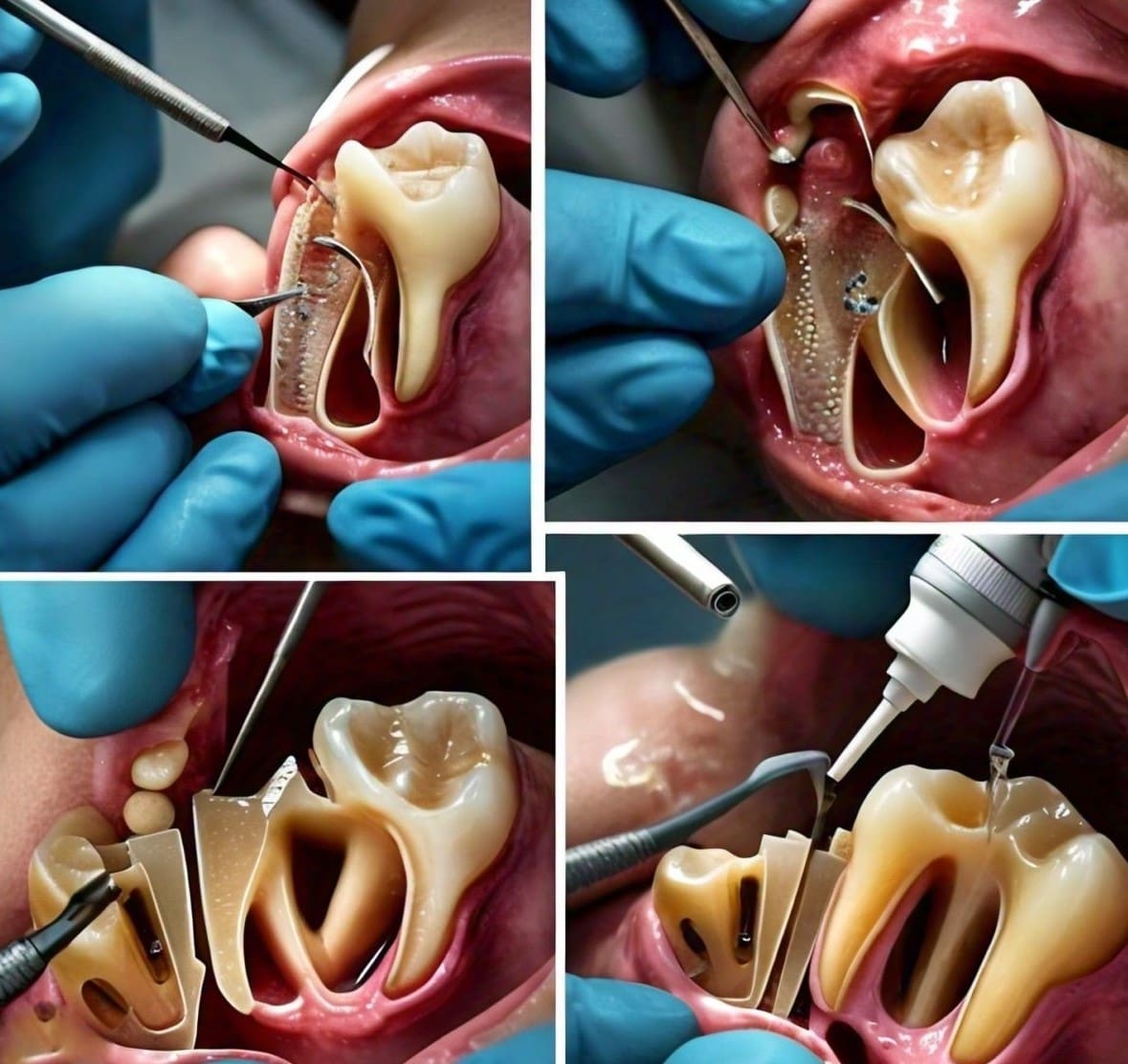Root canal treatment is often shrouded in mystery and anxiety, but with the right information, patients can navigate this dental procedure with confidence. In ‘The Ultimate Guide to Understanding Root Canal Therapy,’ we’ll demystify the process, explore the importance of treatment, and answer common questions to equip you with the knowledge needed for a successful dental experience.
Key Takeaways
- Root canal therapy is a crucial procedure for treating infected or damaged tooth pulp, aiming to save the tooth and maintain oral health.
- Understanding the process, potential complications, and aftercare is essential for alleviating fear and ensuring informed decisions about root canal treatment.
- Regular dental check-ups and good oral hygiene can prevent the need for root canal therapy, but when necessary, it offers a high success rate and preserves the natural tooth structure.
Comprehensive Guide: Factors to Consider for Root Canal Treatment

What Does Root Canal Treatment Entail?
Root canal treatment, or endodontic therapy, is a dental procedure aimed at addressing problems within the tooth’s pulp chamber. This inner area houses the tooth’s nerves and blood vessels, which can become infected due to deep decay or injury. The steps involved in a root canal include:
- Removal of the infected or inflamed pulp
- Cleaning and disinfecting the inside of the tooth
- Filling and sealing the space with a rubber-like material called gutta-percha
- Restoring the tooth with a filling or crown for protection and functionality
The goal of this treatment is to preserve the natural tooth and prevent further issues. If you’re experiencing severe tooth pain or sensitivity, it’s crucial to seek professional advice to determine if a root canal is necessary. The procedure itself is typically painless, thanks to modern techniques and anesthesia, and it can save a tooth that might otherwise need to be extracted.
Do I Require Root Canal Therapy?
Determining the necessity for root canal therapy hinges on the condition of your tooth. Severe decay or pain, especially when pressure is applied, are telltale signs that you may need this treatment. It is crucial to seek a dental professional’s diagnosis to identify any underlying issues accurately.
Key indicators that suggest the need for root canal therapy include:
- Persistent toothache
- Sensitivity to hot or cold temperatures
- Swelling or tenderness in the gums
- Discoloration of the tooth
- A visible crack or damage to the tooth
If you experience any of these symptoms, it is imperative to consult with your dentist promptly. They will evaluate your situation and may recommend a root canal procedure to prevent further damage and preserve your tooth’s integrity.
Advantages of Root Canal Treatment
Root canal therapy offers significant benefits, foremost of which is the preservation of your natural tooth. Maintaining your original tooth provides superior function and feel compared to alternatives like dentures or implants. Additionally, this treatment can prevent further dental complications and expenses.
The procedure itself has become highly efficient and, with modern advancements in dental technology and anesthesia, is typically associated with minimal discomfort. Most patients find root canal therapy to be a cost-effective solution, often requiring only one or two visits to complete, whereas alternatives may necessitate multiple follow-ups.
Key advantages include:
- Preservation of natural teeth
- Minimized discomfort due to modern techniques
- Cost-effectiveness over tooth extraction and replacement
- Aesthetic restoration of damaged teeth
By choosing root canal treatment, you are opting for a reliable method to save a compromised tooth and ensure the longevity of your dental health.
The Hazards of Neglecting a Dental Infection
Ignoring the signs of a dental infection can lead to a cascade of detrimental health effects. An untreated tooth abscess or infection may not only cause severe pain and discomfort but can also result in more serious conditions such as nerve damage, facial swelling, and tooth discoloration. These symptoms are your body’s way of signaling that something is amiss and requires immediate attention.
The consequences of delaying treatment extend beyond the immediate discomfort. An infection can spread to other parts of the mouth and even to the rest of the body, leading to systemic health issues. This is why prompt action is necessary to prevent the infection from worsening.
To avoid such complications, it is imperative to seek professional dental care as soon as symptoms arise. Regular dental check-ups are also crucial in detecting and addressing any potential issues before they escalate into more severe problems.
Progression of a Root Canal Procedure
Understanding the progression of a root canal procedure can help alleviate any apprehensions you may have. Initially, your dentist will diagnose the issue and take necessary x-rays of the affected tooth and surrounding areas. After a thorough examination, a personalized treatment plan is crafted to ensure optimal results for your specific case.
The procedure begins with the administration of local anesthesia to numb the area, followed by the placement of a dental dam to isolate the tooth and keep it clean and dry. The dentist then creates an opening in the tooth to access the infected pulp. The pulp is carefully removed, and the root canal system is meticulously cleaned and disinfected.
The final steps involve filling the root canal with a biocompatible material, usually gutta-percha, and then sealing the tooth with a temporary or permanent filling or crown. This restoration process is crucial as it protects the tooth from further damage and restores its full functionality. Typically, the entire process is completed in one or two visits, depending on the complexity of the case.
Ways to Avoid Root Canal Treatment
Maintaining optimal oral hygiene is the cornerstone of preventing the need for root canal therapy. Regular brushing and flossing are essential to remove plaque and prevent the development of cavities that could lead to infection. Here are some proactive measures you can adopt:
- Ensure you brush at least twice a day and floss daily to keep your teeth and gums healthy.
- Utilize a mouthguard during sports or activities that could result in dental injuries.
- Schedule routine dental check-ups and cleanings to detect and address issues early on.
Limiting the intake of foods and beverages that are hard, sugary, or acidic is also beneficial as they can contribute to tooth decay. By adopting these practices, you can significantly reduce the likelihood of requiring root canal treatment and maintain a healthy smile.
Root Canal Expenses at Care Dental Online
Understanding the cost of root canal therapy is crucial for your financial planning. At Care Dental Online in Quincy, MA, the price of a root canal procedure is influenced by several factors, including the severity of the infection and the specific tooth affected. Our commitment is to ensure that you receive the highest standard of care at a reasonable cost.
- The complexity of your case may affect the total cost.
- Your dental insurance coverage can significantly reduce out-of-pocket expenses.
- We offer various payment plans to accommodate your budget.
We encourage you to discuss your financial options with our staff. Transparency in treatment costs is a priority, so you can make informed decisions about your dental health without any surprises.
Regenerative Endodontic Procedures
Regenerative endodontic procedures represent a cutting-edge advancement in dental care, focusing on the revival of the tooth’s natural tissues and promoting continuous root development. Unlike traditional root canal treatments, this innovative approach aims to reinforce the hard tissues of the tooth, thereby reducing the risk of future fractures.
This technique is particularly beneficial for younger patients, as it offers the possibility of preserving their natural teeth for a lifetime. The process typically involves:
- Removal of inflamed or infected tissue within the tooth
- Application of disinfectants and antibiotics to clean the canal system
- Introduction of materials and growth factors to stimulate tissue regeneration
- Monitoring of the tooth over time to ensure successful healing and development
As with any dental procedure, it is crucial to consult with your endodontist to determine if regenerative endodontic procedures are suitable for your specific condition. The promise of regenerative endodontics lies in its potential to not only save but also rejuvenate teeth, providing a more natural and durable solution to dental health issues.
Endodontic Retreatment
Occasionally, a tooth may not heal as expected after a root canal or might continue to be symptomatic. Endodontic retreatment is the subsequent step to address such issues. This procedure involves the removal of the existing filling materials, the re-cleaning of the root canals, and the re-sealing of the tooth. Here are the typical reasons for considering retreatment:
- Persistent symptoms or discomfort
- Complex canal anatomy not fully treated in the initial procedure
- Delayed placement of the crown or other restoration
- New decay exposing the root canal filling material to bacteria
If you find yourself in need of endodontic retreatment, it is crucial to seek prompt care to prevent further complications. The goal is to preserve your tooth and maintain your natural smile for as long as possible.
Trauma Management for Dental Injuries
Dental injuries from accidents or sports can be distressing, but timely management is key to preventing further complications. Immediate attention to broken or dislodged teeth is crucial to avoid infections, difficulties in cleaning, and potential tooth loss.
At Care Dental Online in Quincy, MA, you will receive expert care from endodontic specialists who prioritize your oral health. They combine their extensive experience with a deep understanding of dental trauma to provide care that is both specialized and personalized.
The steps involved in managing dental trauma include:
- Thorough examination to assess the extent of injury
- Discussion of treatment options tailored to your specific needs
- Implementation of the chosen procedure with a focus on pain minimization and long-term dental health
It is imperative to seek professional help if you experience a dental injury. Our team at Care Dental Online in Quincy, MA, is equipped to handle such emergencies and guide you towards a swift and effective recovery.
Root Canal Therapy FAQs

What Exactly Is a Root Canal Treatment?
Root canal treatment, or endodontic therapy, is a dental procedure aimed at saving a tooth that is severely decayed or infected. The essence of the treatment is to remove the infected or inflamed pulp, which is the soft inner tissue of your tooth containing nerves, blood vessels, and connective tissue.
The procedure typically involves the following steps:
- Administering a local anesthetic to ensure your comfort.
- Creating an opening in the crown of the tooth to access the pulp chamber.
- Removing the pulp and cleaning the root canal system.
- Filling the canals with a biocompatible material, usually gutta-percha, to support the tooth structure.
- Sealing the opening with a temporary or permanent filling or crown to restore the tooth’s function and appearance.
By undergoing root canal therapy, you are not only relieving pain but also preserving the integrity of your natural tooth, preventing the spread of infection, and avoiding potential tooth loss.
Do I Need Root Canal Therapy?
Determining whether you require root canal therapy hinges on the health of your tooth. If you experience intense pain or sensitivity to pressure, it’s imperative to seek a dental professional’s evaluation. They can discern the root cause and decide if root canal therapy is necessary.
Signs that may indicate the need for this treatment include:
- Persistent toothache
- Sensitivity to hot or cold temperatures
- Swollen or tender gums
- Discoloration of the tooth
- A pimple-like bump on the gums near the affected tooth
Should any of these symptoms arise, do not hesitate to contact your dentist. Prompt attention to dental discomfort not only alleviates pain but also prevents potential complications.
What Occurs During an Endodontic Procedure?
During a root canal treatment, the primary goal is to remove the infected or inflamed pulp from within the tooth. Initially, a dental dam is installed to isolate the tooth and keep it dry. Following this, an access opening is carefully made in the tooth’s surface to reach the pulp chamber. Using specialized dental instruments, the pulp – comprising connective tissue, blood vessels, and nerves – is meticulously removed.
Once the pulp is extracted, the next step involves cleaning and disinfecting the interior canals of the tooth. After ensuring the canals are free of infection, they are filled with a biocompatible material, typically gutta-percha, to seal them off from further bacterial invasion. The final stage of the procedure includes the restoration of the tooth with a filling or crown, which helps to protect the tooth and restore its full functionality.
The success rate of root canal treatments is notably high, and when performed effectively, it preserves the tooth’s natural appearance and function, thus preventing the need for extraction. It is essential to understand that while the procedure is designed to be painless, preparation and proper aftercare are crucial for a comfortable recovery.
How Long Does a Root Canal Operation Endure?
The duration of a root canal operation can vary depending on the complexity of the case and the tooth involved. A simple root canal treatment typically takes about 30 minutes to an hour. However, for a more involved procedure, such as one on a molar with multiple roots, the process can extend to approximately 90 minutes.
- Incisors and canines, with usually just one root, can be completed in about 45 minutes.
- Premolars, with one or two roots, may take up to an hour.
- Molars, which can have up to four roots, are the most time-consuming, averaging around 90 minutes.
It is essential to allocate additional time for preparation and recovery when scheduling your appointment. While the treatment itself is efficient, the total time spent in the dental office may be longer to ensure the highest quality of care.
Is a Root Canal Process Painful?
The perception of pain during root canal therapy is a common concern. However, with modern dental techniques and local anesthesia, the procedure is typically virtually painless. Discomfort is usually minimal and can be managed effectively post-treatment.
During the procedure:
- Local anesthesia is administered to numb the affected area.
- Sedation options are available for those with dental anxiety.
- The infected pulp is removed, and the tooth is cleaned and sealed.
After the procedure, it’s normal to experience some minor discomfort, often due to the duration of having your mouth open. This sensation generally subsides within a few days. Should you encounter severe pain afterwards, it’s crucial to contact your dentist promptly to address any issues.
Can You Eat After a Root Canal?
After undergoing root canal therapy, it is crucial to wait until the anesthesia has completely worn off before attempting to eat. This precaution is necessary to prevent biting your tongue or cheek while still numb. Once you are able to feel your mouth normally, you may consume food, but it is advisable to adhere to a diet of soft foods for the initial days following the procedure.
Chewing on the side of the mouth opposite the treated tooth can help avoid discomfort and protect the tooth that has just received treatment. Here are some recommended food options to consider:
- Smoothies
- Dairy puddings
- Milkshakes
- Soft-cooked eggs
- Soups
It is also important to avoid very hot or cold foods as they may cause discomfort. By following these guidelines, you can ensure a smoother recovery and avoid complications.
Conclusion
Root canal therapy, while often misunderstood, is a crucial dental procedure that can prevent tooth loss and alleviate pain caused by infection or damage to the tooth pulp. Throughout this guide, we’ve explored the intricacies of root canal treatment, from the initial signs that may indicate the need for therapy to the post-procedure care that ensures lasting results. By demystifying the process and addressing common concerns, we aim to empower patients with the knowledge to approach root canal therapy with confidence. Remember, preserving your natural teeth is vital for maintaining oral health and overall well-being. If you suspect you may need root canal treatment, consult with a trusted dental professional to discuss your options and take the next step towards a healthier smile.


